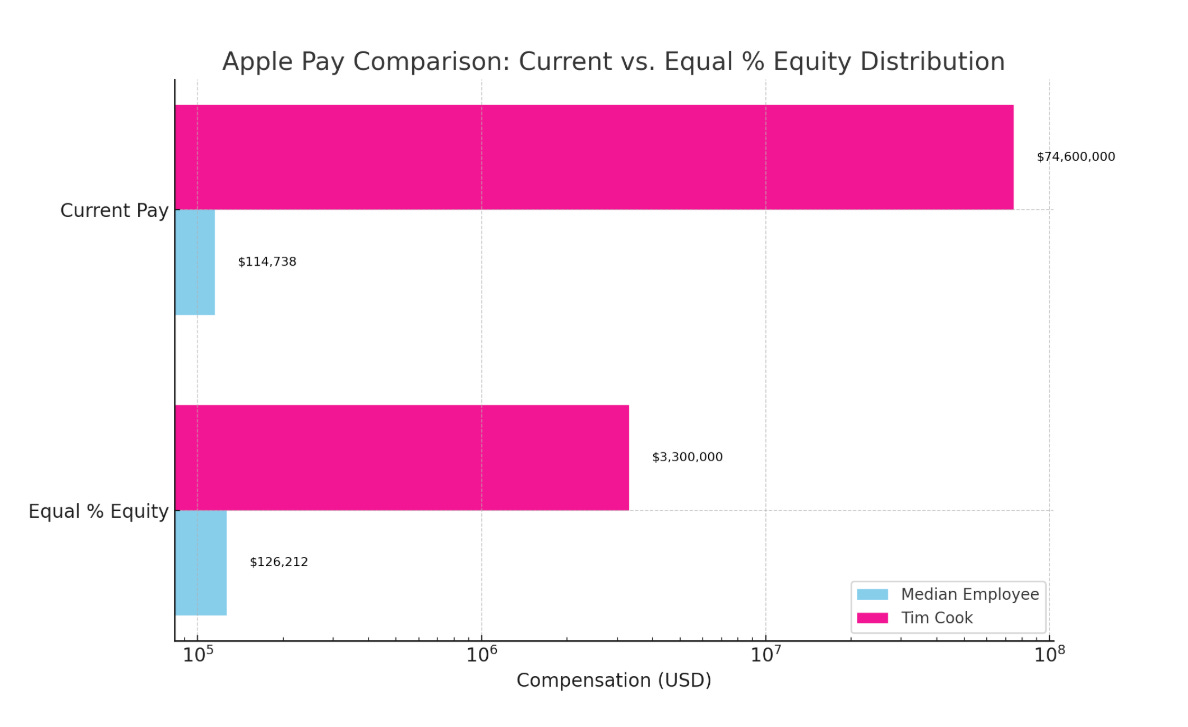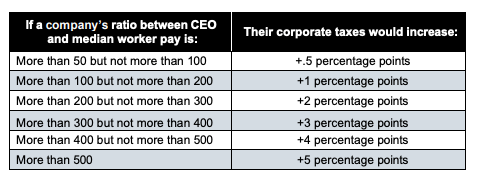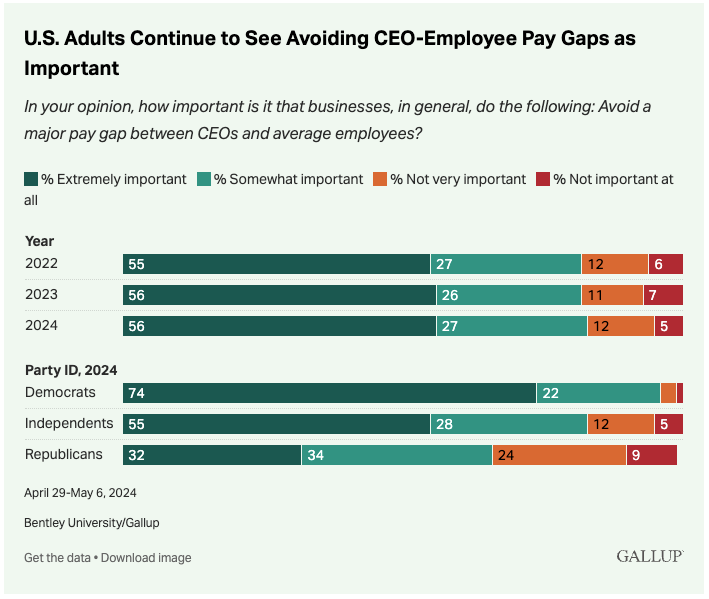Mark Cuban’s right—end exorbitant CEO pay
A version of his plan is already being trialed in San Francisco and Seattle.
Mark Cuban thinks we should end exorbitant pay for executives.
“I would create tax incentives for companies that rewarded all of their employees with a pari passu-type ratio of stock rewards to income,” he said on a recent podcast. “If the CEO gets $100,000 worth of stock and makes $1 million, that’s 10%. The person working the front desk who makes $40,000 gets 10%. I think that’s the path to income equality.
“You have to increase people’s asset base in order for them to have assets that appreciate and keep up. Because if you don’t have assets that appreciate, you can’t ever keep up.”
If all employees earned the same percentage of stock relative to their salary, wage inequality would be eradicated.
The median Apple employee currently earns $114,738 annually, but CEO Tim Cook makes 650 times that at $74.6 million. If both employees earned 10% of their salary in stock, the salaried employee would earn an additional $11,474 in stock value each year. But Cook, who earns only $3 million of his total compensation in salary, would earn nearly $58 million less—about $300,000 in stock rather than $58 million.
Tim Cook would go from earning 650x more than the median employee, to only 26x more—the size of the wage gap in America when it was at its most equitable.
In 1965, American CEOs were earning only 20x the typical worker. A scientist or engineer working in the Bay Area might live in the same neighborhood as the CEO—they’d send their kids to the same school and mow their own lawns. But by 1978, CEOs were making 30x the typical worker, by 1989 it was 59x. Today, CEOs at private companies earn about 174x the median worker, and those at public companies earn 290x. A scientist or engineer working in Silicon Valley today might watch executives drive a Ferrari to work and helicopter to Tahoe for the weekend—they live in very different neighborhoods and their children go to very different schools.
Now there are calls to return America to its most equitable. JP Morgan once put the ideal wage gap at 20x, management expert Peter Drucker later agreed, saying wage gaps above that breed resentment and falling morale. Today, only Norwegian companies accomplish that ideal, with executives earning 20x the national average. Singapore is second with executives earning 56x, and Sweden is third with a wage gap of 60x. As countries like Germany (136x), Canada (149x) and the UK (200x) approach wage gaps that rival the US’ (265x), citizens are clamoring for a solution.
Last month, Bernie Sanders ventured just such a fix—and one not too far off from Cuban’s.
His Tax Excessive CEO Pay Act, if enacted, would increase corporate tax rates on companies with exorbitant pay ratios. Companies paying executives 50x what median workers earn would see taxes increase by 0.5%. Companies paying executives 100x, by 1%, and so on. The tax would apply to companies with gross receipts of $100 million over three years, and built-in measures ensure companies can’t outsource labor to increase their median wage.
If current pay ratios continue, this tax would raise $150 billion in tax revenue over 10 years. If it were in place last year, the government would have raised $3 billion from Amazon alone—at $32.4 million CEO Adam Selipsky earns a whopping 1,995x the median worker.
Portland, Oregon was the first to try it.
The city began taxing public companies with exorbitant pay ratios in 2017.1 San Francisco followed suit in 2020, with 65% voting to tax companies with 100x wage gaps.2 The tax is already raising $125 million a year from companies like Salesforce. This year, Seattle joined the charge, voting overwhelmingly to tax companies that pay executives more than $1 million, even as Amazon, Microsoft, and T-Mobile fought to contest it.3 The State of Washington has since proposed a bill to tax hospitals with excessive executive pay—7.5% of their top 5 salaries would go toward funding healthcare in the state.
The fact that cities like San Francisco and Seattle—in some of the highest income brackets and with the highest prevalence of wealthy tech firms—are voting overwhelmingly in favor of such tax bills is proof of their feasibility.
“The reason I like working on CEO pay issues so much is because there is a lot of common ground among ordinary Americans across the political spectrum on this issue,” Sarah Anderson, Global Economy Project Director at the Institute for Policy Studies told me. “The people want this kind of thing.”
Anderson was an advisor on the Sanders Act, and she thinks passing more versions locally will help us reach federal support. “Bold ideas like this bubble up from the base and out,” she says. “I would love to see more state and local experiments proving that it can work and that the sky isn’t going to fall, as the corporate lobbyists are going to say.”
We’ve seen similar upsets at the local level recently. When Zohran Mamdani won the primary for New York’s mayor this year—advocating for universal childcare—we saw just how much citizens in even the wealthiest cities want a more equitable society. He won by 56% despite his opponent earning millions from wealthy donors who don’t want to see their tax bill increase.
That doesn’t mean it won’t be an uphill battle. “Companies would pull out the stops to block this,” Anderson says. “I mean, they fought like crazy against the regulation that requires them to report the gap between CEO and worker pay. It took us at least five years to get that into force because the corporate lobby groups fought it so hard.”
But if money at the top of companies doesn’t want to see it, nearly everyone else does. Few think CEOs are worth 300 times the median wage, much less 1,000, and that’s true for all political affiliations. Companies would only benefit from pay models that motivate and reward the whole company rather than just the guy at the top.
There’s no hard cap here, nothing that hampers innovation or reduces corporate profits. “It’s important to point out that companies would have a choice, right?” Anderson says. “They wouldn’t have to pay more taxes. They could narrow their pay gaps and let their competitors pay more taxes.”
This should encourage cities across the world to put it to a vote. Personally, I’m partial to Cuban’s plan—incentivize companies to apply the same equity percentage across all employees. That would, not just reduce the wage gap, but also give everyone access to income-generating assets. But not all stocks are liquid so this would solely benefit those working for public companies, or with a forthcoming exit. For this reason, Sanders’ idea is a good one too—tax companies with wage ratios above 50x. That might encourage the same outcome as Cuban: Increasing the pay of median workers while encouraging a more equitable pay gap at all companies.
Cuban and Sanders would both tax stock buybacks as part of the deal. Companies use cash to buy more of their own stock and artificially inflate the company’s value on the stock market, and Sanders would raise taxes on these purchases from 1% to 4%. Cuban would carve out an exemption for companies that apply his pari passu ratio. The problem with stock buybacks, he says, is that they enrich executives and shareholders disproportionately as the company increases in value. If employees are cut in on the deal, then by all means.
Altogether, acts like these incentivize companies to use their millions of dollars in value for the good of all their employees, not just the executives at the top. And if they don’t, then it taxes them for the good of the community they are headquartered in.
I do worry that tax incentives won’t be enough. Though they might encourage small firms to ensure healthy wage gaps, large firms like Apple, Microsoft, and NVIDIA might just pay to play. So far, no firms in San Francisco or Seattle show signs of adjusting executive pay—the wage gap continues, albeit with better tax benefits for both towns. Sanders’ plan feels like a minor, politically feasible act probably designed to encourage cross-aisle support, more aggressive tax increases—by 10% or 15%—might prove a more active deterrent.
Anderson, however, assures me these taxes would have massive results. Almost every American company is paying executives far more than 100x their median employees, and they would feel the heat. “If it was adopted at the federal level, like under the Sanders bill, then I think shareholders would start asking tough questions about whether it’s really worth having these extreme pay gaps when it would hit the bottom line of the company in terms of an increased IRS Bill.”
Tax incentives have been used to encourage retirement savings, healthcare savings accounts, and employee-owned companies. We should absolutely use them now to reduce the wage gap. Even if corporate executives fight it at every turn, workers make up the majority of the voting base and are ready for a change.
Let’s take it to the cities and see what they say.
Thank you
and Hara Kumar for editing an earlier draft.Thank you all for reading,
If companies pay executives 100x the median worker, they are charged a 10% surcharge on their Business License Tax. If they pay executives 250x median workers, they pay a 25% surcharge.
Companies paying executives 100x median workers pay an extra 0.1% of their gross receipts to the city. Companies paying 200x pay 0.2%. And so on, up to 0.6%.
Corporations pay a 5% tax on every dollar they pay employees earning more than $1 million.







I applaud both Cuban and Sanders for their ideas on how to address the very real problem of wealth inequality. Income taxes and/or tax incentives are clearly good tools to use, and I think estate taxes are another tool which should be used to limit how much wealth can be passed on to future generations.
I don’t believe any CEO is worth more than 100x their median employee compensation. In fact, one can easily argue it should be only 20-50x.
If a board of directors truly wants to drive their company’s business (and their stock price), they should engage all their employees by incentivizing them along the same lines as the C-suite personnel.
This means significant equity, profit sharing, incentives, bonuses, competitive salary, and attractive benefits (sabbaticals) for all employees. This will align all employees with the company mission and goals. Turnover and training costs will be significantly reduced, and profitability & efficiency will soar with everyone rowing in the same direction.
If you haven’t already, I can also highly recommend Ingrid Robeyns’ Limitarianism in this same vein!